Family Fun Coloring Pages
Popular Black Lake Fish:
Fish Species
A List of Fish to be caught in Black Lake. They’re in there, all you gotta do is CATCH’EM.
Latin Name: Micropterus salmoides
Season/Limits
June 15 – Nov 30 (No catch and release outside of open season)
Minimum Length- 15″
Daily Limit- 5 (Large & Smallmouth combined)
Common Names
Largemouth, Bigmouth Bass, Black Bass, Green Trout, Hawg, Oswego Bass, Green Bass, Bucketmouth
Characteristics
Body green-shaded with a broad, continuous dark stripe along each side, belly white to yellowish, dorsal fin almost completely separated between spiny and soft portion and lower jaw extends past the gold-colored eye.
Habitat and Distribution
Found in every state in the US and as far south as Mexico and north into Canada, Largemouth like sluggish large and small streams. They can be found in as little water as a puddle to vast stretches. They thrive in weedy, shallow lakes and backwaters. They are found in water no deeper than 20 feet, and do not stray from areas such as logs, debris, stumps, and weed beds.
Foods
Fish, frogs, crayfish, aquatic insects

Latin Name: Micropterus dolomieui
Season/Limits
June 15 – Nov 30 (No catch and release outside of open season)
Minimum Length- 15″
Daily Limit- 5 (Large & Smallmouth combined)
Common Names
Smallmouth bass, black bass, bronzeback, smallie
Characteristics
Brown, golden-brown through olive to green on back, with faint, wavy olive blotches along the sides, 5 olive-green bars radiate back from the red eye and 1 radiates forward.
Habitat and Distribution
Native to New England, southern Canada, the Great Lakes area and in large rivers of Tennessee, Arkansas, Oklahoma, this species can be found in moderate and cooler climates coast to coast. This fish likes deep, large lakes and large rivers. Smallmouth bass can also be found in streams where there is moderate current and gravel points. In lakes, look for the bass near gravel bars, shoals, weed beds and near drop-offs.
Foods
Fish, crustaceans, larger insects
Inch for inch and pound for pound,the Smallmouth Bass is the gamiest fish that swims.
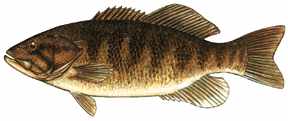
Latin Name: Stizostedion vitreum
Season/Limits
May 1 – March 15
Minimum Length- 18″
Daily Limit- 3
Common Names
Walleye, walleyed pike, pike, jack, jackfish, pickerel, yellow pickerel, blue pickerel, pike perch
Characteristics
Brassy olive-brown to golden-brown to yellow on back, paler sides with no distinct bars or mottlings, but caudal fin has white tip on lower lobe, yellowish white underside, white glossy eyes and sharp teeth.
Habitat and Distribution
The largest member of the perch family can be found in most of Canada, and as far north as the Great Slave Lake and Labrador. In the US, it is limited to the northern states but stocking and breeding has increased its presence in all of the East and most of the far-west and south. This perch loves clear, cold, deep waters in lakes and rivers, but it prefers a sand, gravel, or rock bottom. Walleye are schooling fish, so once you catch one, more are to follow.
Foods
Mostly fish; other aquatic animals
Anglers enjoy Walleye year-round as strong, if unspectacular, game fish. During the day, these large-finned, brassy-colored fish often rest on the bottom, hovering in the shade of submerged objects or in the shadows of deep water. They emerge at dusk to feed over shallow weed beds or rocky shoals. In midsummer, they often remain near the bottom, even at night.
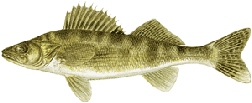
Latin Name: Pomoxis nigromaculatus
Season/Limits
No Closed Season
Minimum Length- 10″
Daily Limit- 25
Common Names
Crappie, Croppie, Calico, Papermouth, Calico Bass, Grass Bass, Strawberry Bass
Characteristics
Silvery with a dark back and green or blackish mottling on the sides, hump-backed, with 7-8 spines in the dorsal fin; most of those caught by anglers are 6 to 10 inches in length.
Habitat and Distribution
Black Crappie are found from southern Manitoba to southern Quebec and from Nebraska to the Eastern seaboard. They are also found in the South from Texas to Florida. Black crappies, like white crappies prefer a similar habitat: turbid, silty rivers and lakes. They congregate in weeds and grasses.
Foods
Small fish, aquatic insects and their larvae
Fish in brushy areas, if you aren’t getting snagged often, you aren’t fishing where the fish are!
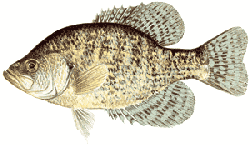
Latin Name: Lepomis macrochirus
Season/Limits
No Closed Season
Daily Limit- 50 (Bluegill, Sunfish combined)
Common Names
Bluegill Sunfish, Bream, Sun Perch, Blue Perch, Blue Sunfish, Copperbelly, Red-Brested Bream, Copperhead Bream, Blue Bream
Characteristics
Dark olive-green back and sides yellow or reddish below dark vertical bars usually present on sides, chin and gill covers bright blue, black, flexible tip at rear of gill cover, seldom exceed 8 inches.
Habitat and Distribution
Bluegill are found across the continental United States. Bluegill like to live in quiet, weedy streams and lakes. During the daytime, smaller Bluegill congregate near coves and under over hanging trees and docks; larger fish prefer deep water coming in to feed during the early morning and late afternoon.
Foods
Aquatic insects, small fish and crayfish
Use small hooks (#8) with a long shank when fishing with live bait for bluegill
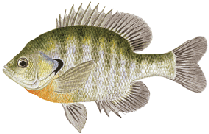
Latin Name: Perca flavescens
Season/Limits
No Closed Season
Daily Limit- 50
Common Names
Bright green to olive to golden brown on back, yellow-green, yellow on sides with 7 dark vertical bars, grey to milk-white below
Foods
Small fishes, aquatic insects, small crayfish and snails
Yellow perch are great fun to catch through the ice and tasty too! Use ice jigs with plenty of flash.

Latin Name: Ambloplites rupestris
Season/Limits
No Closed Season
No Limits
Common Names
Rock Bass, Rocky, Redeye
Characteristics
Olive colored with brassy reflections and dark motlings along the sides, whitish breast and belly, 6 spines in anal fin and 12 in the dorsal, seldom exceed 10 inches.
Foods
Aquatic insects, minnows and other small fish
True to their name, the rock bass can be caught by fishing close to the rocks near the current
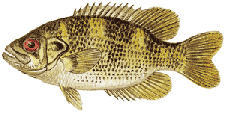
Latin Name: Esox lucius
Season/Limits
May 1 – March 15
Minimum Length- 18″
Daily Limit- 5
Common Names
Northern Pike, Pike, Northern, Snake, Great Northern, Jackfish, Jack, Hammer Handle
Characteristics
Dark shades green, through olive green to brown on back with irregular rows of light yellow or gold spots on sides (color extremely variable),cheek fully scaled, but lower 1/2 of opercle scaleless. Cream to milk-white on underside.
Habitat and Distribution
Pike are generally found in most northern waters, especially from Alaska east to Labrador and south from the Dakota’s and the St. Lawrence River to Nebraska and Pennsylvania. Stocked pike can be found in Montana, Colorado, North Carolina and Maryland. Pike like to live in shallow, weedy, large, small and deep lakes and rivers. They can tolerate rivers with medium current.
Foods
Besides smaller fish, its diet includes frogs, crayfish, small mammals and birds — almost anything within range.
Without a doubt, the northern pike is a voracious predator — consuming three to four times its weight during the course of a year. Big lures with lots of flash entice feeding northerns

Latin Name: Esox masquinongy
Season/Limits
June 1 – Nov 30
Minimum Length- 40″
Daily Limit- 1
Common Names
Maskinoge, Muskie, Pike, Blue Pike, Great Pike, Jack, Spotted Muskellunge, Barred Muskellunge, Tiger Muskellunge
Characteristics
Olive to dark gray above, sides lighter with dark spots or bars, upper 1/2 of cheeks and opercle lightly scaled, lower 1/2 of both scaleless; approximately 36 inches in length at age 5. Muskie are often confused with northern pike, however muskies have dark marks on a light background and pointier tips on the tail.
Habitat and Distribution
Muskellunge can be found as far north as James Bay and Hudson Bay drainages in northern Canada, across the northern US from Wisconsin to the Middle Atlantic States south into Tennessee, North Carolina, Georgia and in much of northern Mississippi drainage. Muskie live in rivers, streams and lakes. They prefer cold water but can tolerate temperatures up to 70 F
Foods
Mostly fish
The Muskie has been called the fish of 10,000 casts, be patient and use BIG lures

Latin Name: Ictalurus punctatus
Season/Limits
No Closed Season
No Limits
Common Names
Spotted Cat, Blue Channel Cat, River Catfish
Characteristics
Channel catfish closely resemble blue catfish. Both have deeply forked tails. However, channels have a rounded anal fin with 24-29 rays and scattered black spots along their back and sides. They have a small, narrow head. The back is blue-gray with light blue to silvery-gray sides and a white belly. Larger channels lose the black spots and also take on a blue-black coloration on the back which shades to white on the belly. Males also become very dark during spawning season and develop a thickened pad on their head.
Habitat and Distribution
Channel catfish inhabit large rivers and lakes from the Great Lakes region south to Mexico. Like many other species, channel catfish have been transplanted to other areas of the country.
Foods
Fish, aquatic invertebrates, plant material
The worse it smells the more likely a channel cat will bite on it.

Latin Name: Ameiurus nebulosus
Season/Limits
No Closed Season
No Limits
Common Names
Creek Cat, Mud Cat, Horned Pout, Red Cat, Speckled Cat
Characteristics
The chin barbels on browns are pigmented, not whitish as with yellow bullheads. The sides of brown bullheads have a distinct, irregular brownish mottling over a light background. The belly is creamy white. They have square tails and 20 to 24 anal ray fins.
Habitat and Distribution
Browns generally inhabit still or slowly-flowing warm waters in ponds, lakes, reservoirs, large rivers and sluggish streams. They prefer water temperatures of 78 to 82 degrees, but can survive in warmer waters. They inhabit areas with mud or deep muck as well as sand or gravel bottoms.
Foods
They are primarily bottom feeders, feeding mostly at night. Highly sensitive barbels enable them to smell a wide variety of food such as insects, plant material, carrion, small fish, snails, crayfish, worms and leeches.

Latin Name: Lepisosteus osseus
Season/Limits
No Closed Season
No Limits
Common Names
Gar, Garfish
Characteristics
They are olive-brown or deep green along the back and upper sides, with silver-white bellies. There are a few irregular, large, dark spots on the body. The young display scattered spots over both sides, the upper and lower jaws and on their ventral fins. The longnose is generally distinguished from other gars by its longer, more slender body, and especially by its longer, narrower snout. The snout is twice the length of the rest of the head.
Habitat and Distribution
They inhabit sluggish, sometimes poorly oxygenated water, backwaters and oxbows of medium-to-large rivers and lakes. Longnose gars as well as other gar species are able to tolerate poor water quality by breathing air through its air bladder. They usually are found near vegetation and occasionally in brackish waters.
Foods
Young fish mainly feed on zooplankton while larger ones feed on small fishes, frogs and crustaceans.
A Toothy Critter

Latin Name: Moxostoma valenciennesi
Season/Limits
No Closed Season
No Limits
Characteristics
Generally, redhorses have a dark back and silvery sides, giving a bronze or copper reflection. These fish usually have paired fins with red, orange, or copper tint; some species also have red to orange dorsal, anal, and tail fins. They range in average size from 10 to 18 inches and from 1 to several pounds. As with other suckers, redhorses spawn in spring.
Habitat and Distribution
Several species of redhorse are found in New York-silver, black, golden, greater, and shorthead-although none is particularly common. The shorthead redhorse is probably the most common and is certainly the most widespread species of redhorse in New York State.
Foods
They are bottom feeders, and probably their greatest importance is as food for game fish.

Latin Name: Lepisosteus osseus
Season/Limits
No Closed Season
No Limits
Common Names
Mudfish, Mud Pike, Dogfish, Grindle, Blackfish, Cottonfish, Swamp Bass, Cypress Trout
Characteristics
The bowfin is the only living representative of an ancient family of fishes. It has an air-bladder which functions somewhat like a lung, and they are often seen near the surface of the water, gulping mouthfuls of air. They are easily recognized by the flattened heads, long, stout bodies, large mouths full of small, sharp teeth, long dorsal fins that extend along most of the back, and rounded tails. The pelvic fins are set far back on the belly near the middle of the body and the pectoral fins are low on the sides so that the overall appearance is 1 of 3 sets of fins in a row: the pectorals behind the head, the pelvics near the midbody and the anal fin near the tail. Also 2 short, tube-like barbels are located near the nostrils. The body is olive-green above, shading to pale yellow or cream on the belly. Several dark brown, horizontal bars are often evident on the cheeks. Males have a dark spot with a bright orange halo, on the upper part of the tail fin. The spot is absent or inconspicuous on females.
Habitat and Distribution
This fish prefers swamps, sloughs, pools, and backwaters of lowland streams. Bowfins are usually found near vegetation. They live in warm, poorly oxygenated waters that are uninhabitable to most fishes.
Foods
Crayfish, fishes, frogs, large insects, leeches
Another Toothy Critter
